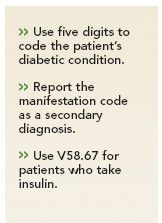Article
Coding Cues
Diabetes diagnoses

Use the correct digits
Determine the fourth digit for 250.xx (diabetes mellitus) according to the type of diabetic complication the patient has (1 for ketoacidosis, 4 for renal conditions, 6 for neurological involvement, etc.). You should code only the complication relevant to the services you render during the visit.
Is the diabetes primary?
After you've chosen the patient's correct 250.xx code, you must decide if diabetes is the primary or secondary diagnosis. You could treat a patient for a problem not directly related to the diabetes, but you may still need to indicate the patient's complete medical condition with a 250.xx code.
There's no hard and fast rule regarding when the diabetes should be the patient's primary or secondary diagnosis. The nature of the presenting problem should govern the diagnosis code. Study these three scenarios to help you determine if you should list diabetes as the primary diagnosis:
You won't find gestational diabetes, a condition that only develops during pregnancy and disappears after delivery, within the 250.xx series. For this type of diabetes, use 648.8x and choose the fifth digit to indicate when the condition or complication occurred. Include V58.67 (long-term [current] use of insulin) if you're treating the condition with insulin.
But for pregnant women who were diabetic before pregnancy, assign 648.0x as the primary code and then the appropriate 250.xx code to identify the type of diabetes.





